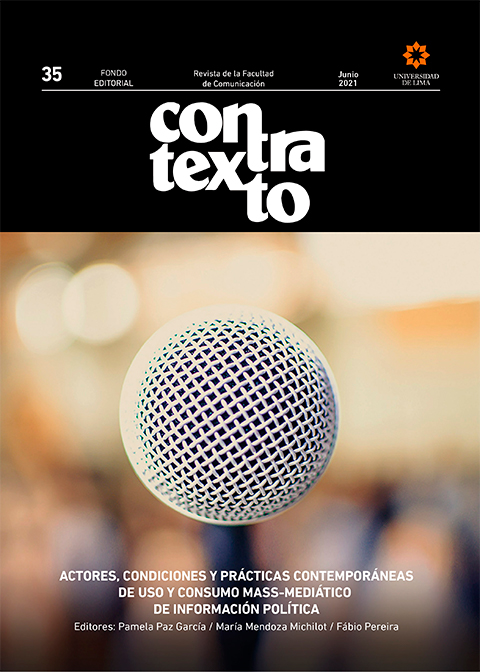The creation of a rite: a semiotic analysis of a union protest through the twitter social network during the state of pandemic
DOI:
https://doi.org/10.26439/contratexto2021.n035.4954Keywords:
semiotics of protest, rite, union protest, cyber protest, subaltern social groupsAbstract
This article aims to analyze protest practices as a ritual registered through the Twitter platform during the state of pandemic. To that end, from a qualitative approach using social semiotics analysis techniques, this research takes as corpus or empirical reality of analysis tweets with audiovisual content posted by the Sanitation Workers’ Union (SITOBUR) from June to September 2020, the time frame during the pandemic in which labor protests were exacerbated. Since the interest is not the becoming protest from the rite but the becoming rite from the protest, the semiotics of the ritual is considered a vital concept for the production of meaning in protest practices, not only from the perspective of its aesthetic performance but also as an element cooperating with the directionality of such practice. The results of the social semiotics analysis lead us to recognize lurking as a significant form of rite which is present in the protests during their spatial, temporal, actantial and practical development.
Downloads
References
Crawford, K. (2009). Following you: disciplines of listening in social media. Continuum: Journal of Media & Cultural Studies, 23(4), 525-535. https://doi.org/10.1080/10304310903003270
Creech, B. (2020). Exploring the politics of visibility: technology, digital representation, and the mediated workings of power. Semiotica, 2020(236-237), 123-139. https://doi.org/10.1515/sem-2018-0043
Defensoría del Pueblo. (2020). Prevención y gestión de conflictos sociales en el contexto de la pandemia por el COVID-19 [informe especial n.° 026-2020-DP]. https://www.defensoria.gob.pe/wp-content/uploads/2020/07/Informe-Especial-026-2020-DP-Prevenci%C3%B3n-y-Gesti%C3%B3n-de-conflictos-APCSG.pdf
De los Ríos, C. V., y Molina, A. (2020). Literacies of refuge: “Pidiendo posada” as ritual of justice. Journal of Literacy Research, 52(1), 32-54. https://doi.org/10.1177/1086296X19897840
Domínguez, F. J., y Malca, M. A. (2019). La representación discursiva del estudiante universitario sanmarquino por la prensa en el Perú: un enfoque desde la lingüística cognitiva. Discurso & Sociedad, 13(4), 576-594. http://www.dissoc.org/ediciones/v13n04/DS13(4)Dominguez&Malca.html
Fillieule, O., y Tartakowsky, D. (2015). La manifestación. Cuando la acción colectiva toma las calles. Siglo Veintiuno Editores.
Finol, J. E. (2006). Rito, espacio y poder en la vida cotidiana. DeSignis, (9), 33-43.
Finol, J. E., y Fernández, J. A. (1999). Etnografía del rito: reciprocidad y ritual funerario entre los guajiros. Revista de la Escuela Nacional de Antropología e Historia, 4(17), 173-186. https://biblat.unam.mx/es/revista/cuicuilco/articulo/etnografia-del-rito-reciprocidad-y-ritual-funerario-entre-los-guajiros
Fontanille, J. (2014). Prácticas semióticas (Trad. D. Blanco). Universidad de Lima, Fondo Editorial.
Geist, I. (2006). El ritual como sintagmática del sentido. DeSignis, (9), 269-286.
Greimas, A. J. (1980). Semiótica y ciencias sociales. Fragua.
Greimas, A. J. (1997). De la imperfección (Trad. R. Dorra). Fondo de Cultura Económica.
Greimas, A. J., y Courtés, J. (1982). Semiótica. Diccionario razonado de la teoría del lenguaje. Gredos.
Greimas, A. J., y Courtés, J. (1991). Diccionario razonado de la teoría del lenguaje (tomo II, Trad. E. Ballón). Gredos.
Kang, W. (2020). I would prefer not not-to: critical theory after Bartleby. Interventions, 23(3), 356-367. https://doi.org/10.1080/1369801X.2020.1762696
Knowlton, T. W. (2015). Literacy and healing: semiotic ideologies and the entextualization of colonial Maya medical incantations. Ethnohistory, 62(3), 573-595. https://doi.org/10.1215/00141801-2890247
Landowski, E. (1993). La sociedad figurada. Ensayos de sociosemiótica. Fondo de Cultura Económica.
Landowski, E. (2007). Presencias del otro. Universidad de Lima, Fondo Editorial.
Landowski, E. (2012). Interacciones arriesgadas (Trad. D. Blanco). Universidad de Lima, Fondo Editorial.
Leone, M. (2012). Breve introducción a la semiótica de protesta. CIC. Cuadernos de Información y Comunicación, 17, 161-173. https://doi.org/10.5209/rev_CIYC.2012.v17.39262
Lotman, I. (1990). Universe of the mind. A semiotic theory of culture (Trad. A. Shukman). Tauris & Co. Ltd. [En español: Lotman, I. (2018). La semiosfera (Trad. D. Blanco). Universidad de Lima, Fondo Editorial].
Marsciani, F. (2007). Tracciati di etnosemiotica. Franco Angeli.
Neumayer, C., y Schoßböck, J. (2011). Political lurkers? Young people in Austria and their political life worlds online. En P. Peter, M. J. Kripp y E. Noealla (Eds.), CeDEM11 Proceedings of the International Conference for E-Democracy and Open Government (pp. 131-143). Edition Donau-Universität Krems. https://bit.ly/2ImcTEZ
Nonnecke, B., Preece, J., y Andrews, D. (2004). What lurkers and posters think of each other. Internet and the Digital Economy Track of the Thirty-Seventh Hawaii International Conference on System Sciences (HICSS-37). https://doi.org/10.1109/HICSS.2004.1265462
Oliveira, A. C. (2014). Interação e sentido nas práticas de vida. Comunicação, Mídia e Consumo, 11(31), 179-198. http://dx.doi.org/10.18568/cmc.v11i31.783
Osisanwo, A., e Iyoha, O. (2020). “We are not terrorist, we are freedom fighters”: discourse representation of the pro-Biafra protest in selected Nigerian newspapers. Discourse & Society, 31(6), 631-647. https://doi.org/10.1177/0957926520939687
Panagiotopoulos, P. (2012). Towards unions 2.0: rethinking the audience of social media engagement. New Technology, Work and Employment, 27(3) 172-192. https://doi.org/10.1111/j.1468-005X.2012.00287.x
Panfichi, A., y Coronel, O. (2014). Régimen político y conflicto social en el Perú: 1968-2011. En N. Henríquez (Ed.), Conflicto social en los Andes: protestas en el Perú y Bolivia (pp. 13-64). Pontificia Universidad Católica del Perú, Fondo Editorial.
Quezada Macchiavello, Ó. (2009). Fiducia: algunos de sus rituales. Contratexto, (017), 87-101. https://doi.org/10.26439/contratexto2009.n017.795
Quezada Macchiavello, Ó. (2014). Interacciones sin nombre. Un caso emblemático: Ne me quitte pas (Cirque du Soleil). Contratexto, (022), 109-125. https://doi.org/10.26439/contratexto2014.n022.91
Quezada Macchiavello, Ó. (2017) Mundo Mezquino. Arte semiótico filosófico. Universidad de Lima, Fondo Editorial.
Real Academia Española (RAE). (2020). Diccionario de la lengua española. https://dle.rae.es/
Sayago, S. (2014). El análisis del discurso como técnica de investigación cualitativa y cuantitativa en las ciencias sociales. Cinta de Moebio, (49), 1-10. http://dx.doi.org/10.4067/S0717-554X2014000100001
Shenton, J. E. (2020). Divided we tweet: the social media poetics of public online shaming. Cultural Dynamics, 32(3), 170-195. https://doi.org/10.1177/0921374020909516
Sokolova, A. (2020). When ritual becomes protest: crossing the bridge of Russian mourning. Journal of the European Institute for Communication and Culture, 27(1), 48-64. https://doi.org/10.1080/13183222.2020.1675424 Solís, M. (2016). El tiempo ritual. Signa: Revista de la Asociación Española de Semiótica, 25, 1119-1129.
Solís, M., y Fontanille, J. (2012). El sosiego ritual. Tópicos del Seminario, 1(27), 15-34.
Strauss, A., y Corbin, J. (2002). Bases de la investigación cualitativa. Técnicas y procedimientos para desarrollar la teoría fundamentada. Sage Publications, Inc., Editorial Universidad de Antioquia.
Sun, N., Rau, P. P. L., y Ma, L. (2014). Understanding lurkers in online communities: a literature review. Computers in Human Behavior, 38, 110-117. http://dx.doi.org/10.1016/j.chb.2014.05.022
Tilly, C. (1978). From mobilization to revolution. Random House.
Vaccari, C., y Valeriani, A. (2015). Follow the leader! Direct and indirect flows of political communication during the 2013 Italian general election campaign. New Media & Society, 17(7), 1025-1042. https://doi.org/10.1177/1461444813511038
Valentine, R., Valentine, D., y Valentine, J. L. (2020). Relationship of George Floyd protests to increases in COVID-19 cases using event study methodology. Journal of Public Health, 42(4), 696-697. https://doi.org/10.1093/pubmed/fdaa127
Vigil, N. (2017). Apuntes para una lectura semiótica del cementerio Nueva Esperanza de Villa María del Triunfo (Lima, Perú). AdVersuS: Revista de Semiótica, (32), 117-129.
Williams, J., Heiser, R., y Chinn, S. J. (2012). Social media posters and lurkers: the impact on team identification and game attendance in minor league baseball. Journal of Direct, Data and Digital Marketing Practice, 13(4), 295-310. https://doi.org/10.1057/dddmp.2011.44
Zilberberg, C. (2006). Semiótica tensiva (Trad. D. Blanco). Universidad de Lima, Fondo Editorial.
Zilberberg, C. (2018). Horizontes de la hipótesis tensiva (Trad. D. Blanco). Universidad de Lima, Fondo Editorial.
Downloads
Published
Issue
Section
License
All of the works published are licensed under a CC BY 4.0 Creative Commons Attribution license. (updated on March 1st 2021)
The content of the journal may be shared in any material or format. The content may be adapted, contributed upon and transformed. Both possibilities are only permitted in so far as they complete the following conditions:
- Attribution: Credit must be given where it is due, a link to the license must be provided and changes, if made, must be indicated. This should be done in the manner deemed appropriate, without suggesting that the licensor promotes you or your use of the material.
Ownership rights
The patrimonial rights for Contratexto are published under a Creative Commons BY 4.0 license, allowing authors to keep the patrimonial rights to their work without restrictions.
If a work published in Contratexto were to be copied, distributed, spread, or any other activities contemplated in the aforementioned license, the author(s) and the journal must be mentioned visibly and expressly.
Self-archive
This journal allows and encourages authors to post items submitted to the journal on personal websites or institutional repositories both prior to and after publication, while providing bibliographic details that credit, if applicable, its publication in this journal.

















